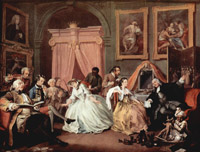period: Classical
 The musical designation "classical period" was first coined in the 1830s to refer especially to the "Viennese School" of Wolfgang Amadeus Mozart and Franz Joseph Haydn, but has since been broadened to subsume the entire period between the more heavily-ornate Baroque and the more emotionally-charged Romantic eras - roughly 1730 to 1800. While admittedly simplistic, the term "classical" does suggest the emphasis on orderly, balanced, and natural musical discourse that marks this period. It is not unrelated that these years correspond to the Enlightenment and the rise of democracy, to which the straightforward and often "popular" approach to musical expression formed a logical counterpart. It is also not surprising that the term "classical" is commonly used by the lay public to connote all of Western Art music, since for many it is the accessible musical syntax of the late 18th century that they most associate with the broader genre.
The musical designation "classical period" was first coined in the 1830s to refer especially to the "Viennese School" of Wolfgang Amadeus Mozart and Franz Joseph Haydn, but has since been broadened to subsume the entire period between the more heavily-ornate Baroque and the more emotionally-charged Romantic eras - roughly 1730 to 1800. While admittedly simplistic, the term "classical" does suggest the emphasis on orderly, balanced, and natural musical discourse that marks this period. It is not unrelated that these years correspond to the Enlightenment and the rise of democracy, to which the straightforward and often "popular" approach to musical expression formed a logical counterpart. It is also not surprising that the term "classical" is commonly used by the lay public to connote all of Western Art music, since for many it is the accessible musical syntax of the late 18th century that they most associate with the broader genre.
In reality, however, the period outlined here was quite dynamic, beginning as a fairly nuanced transition away from the complex approach of contrapuntal composers like J.S. Bach and George Frideric Handel and toward a simpler, more "melodic" approach favored by composers of Italian opera in the 1730s - most notably Giovanni Pergolesi. The new style became known as "galant", suggesting "pleasant" music with clear, periodic melodies and light accompaniment. The galant aesthetic soon spread beyond Italy, and a new musical era was underway - with the older, contrapuntal style (e.g., of J.S. Bach) being labeled as decidedly "old fashioned". By the 1740s and 50s, fresh approaches and techniques were being devised by composers in various musical centers including Johann Stamitz in Mannheim, Giovanni Sammartini in Milan, and J.C. Bach in London; new musical genres (or new approaches to older genres) likewise blossomed during this time, including the symphony, the string quartet, and the piano concerto - the latter signifying the recent triumph of the piano over the harpsichord. Another key development, starting in the late 1760s, was the musical response to the Sturm und Drang ("storm and stress") movement, a literary aesthetic emphasizing extreme emotion and stunning effects - in instrumental works by C.P.E. Bach and, most significantly perhaps, in the operatic reforms of Christoph Gluck. It was the varied richness of these and other developments that the two great figures of the late Classical Era, Haydn and Mozart, synthesized and perfected in the 1780s and 90s. Rumblings of more decisive changes came when a young student of Haydn began testing the harmonic and formal boundaries of the day, in search of a more profound musical expression; his name, of course, was Ludwig van Beethoven - the pioneer of the next era, the Romantic period.

Nolan Gasser, PhD
Artistic Director













